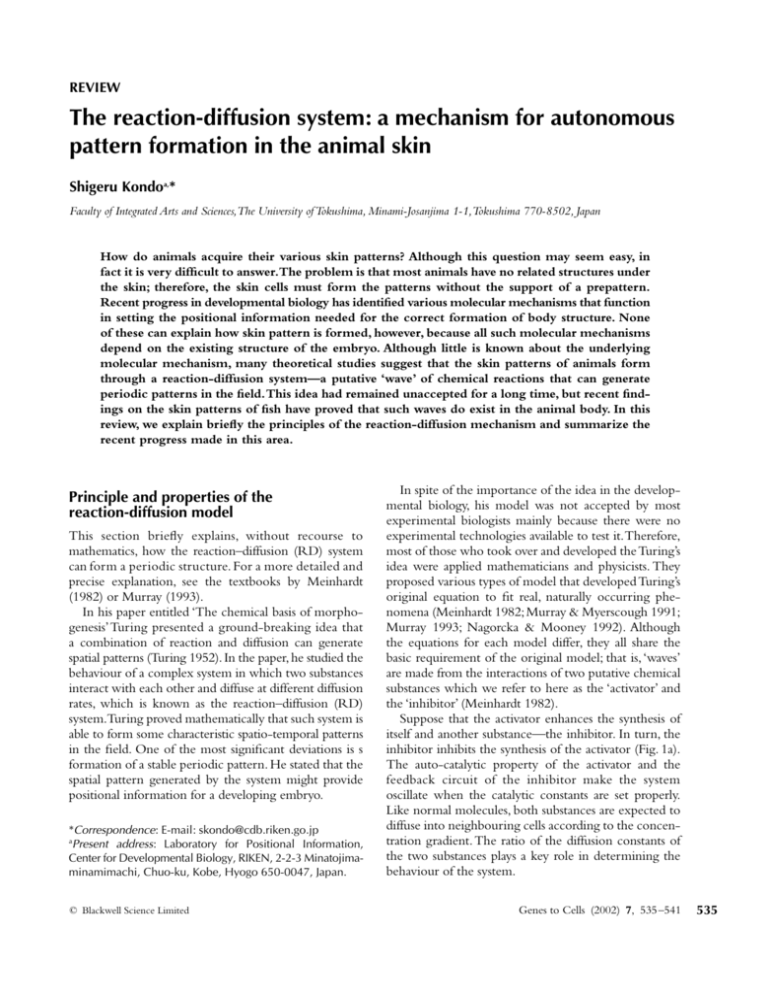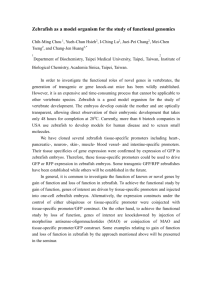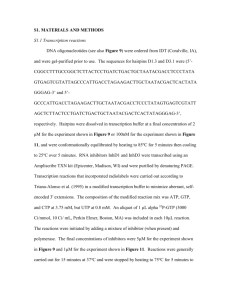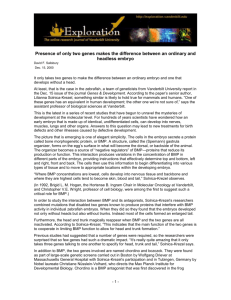a mechanism for autonomous pattern formation in the animal skin
advertisement

REVIEW Genes GTC Blackwell Oxford, © 7?1356-9597 2002 Blackwell toUK Cells Science, Science LtdLtd The reaction-diffusion system: a mechanism for autonomous pattern formation in the animal skin REVIEW SPattern Kondoformation in the animal skin Shigeru Kondoa,* Faculty of Integrated Arts and Sciences,The University of Tokushima, Minami-Josanjima 1-1,Tokushima 770-8502, Japan How do animals acquire their various skin patterns? Although this question may seem easy, in fact it is very difficult to answer.The problem is that most animals have no related structures under the skin; therefore, the skin cells must form the patterns without the support of a prepattern. Recent progress in developmental biology has identified various molecular mechanisms that function in setting the positional information needed for the correct formation of body structure. None of these can explain how skin pattern is formed, however, because all such molecular mechanisms depend on the existing structure of the embryo. Although little is known about the underlying molecular mechanism, many theoretical studies suggest that the skin patterns of animals form through a reaction-diffusion system—a putative ‘wave’ of chemical reactions that can generate periodic patterns in the field. This idea had remained unaccepted for a long time, but recent findings on the skin patterns of fish have proved that such waves do exist in the animal body. In this review, we explain briefly the principles of the reaction-diffusion mechanism and summarize the recent progress made in this area. Principle and properties of the reaction-diffusion model This section briefly explains, without recourse to mathematics, how the reaction–diffusion (RD) system can form a periodic structure. For a more detailed and precise explanation, see the textbooks by Meinhardt (1982) or Murray (1993). In his paper entitled ‘The chemical basis of morphogenesis’ Turing presented a ground-breaking idea that a combination of reaction and diffusion can generate spatial patterns (Turing 1952). In the paper, he studied the behaviour of a complex system in which two substances interact with each other and diffuse at different diffusion rates, which is known as the reaction–diffusion (RD) system.Turing proved mathematically that such system is able to form some characteristic spatio-temporal patterns in the field. One of the most significant deviations is s formation of a stable periodic pattern. He stated that the spatial pattern generated by the system might provide positional information for a developing embryo. *Correspondence: E-mail: skondo@cdb.riken.go.jp a Present address: Laboratory for Positional Information, Center for Developmental Biology, RIKEN, 2-2-3 Minatojimaminamimachi, Chuo-ku, Kobe, Hyogo 650-0047, Japan. © Blackwell Science Limited In spite of the importance of the idea in the developmental biology, his model was not accepted by most experimental biologists mainly because there were no experimental technologies available to test it. Therefore, most of those who took over and developed the Turing’s idea were applied mathematicians and physicists. They proposed various types of model that developed Turing’s original equation to fit real, naturally occurring phenomena (Meinhardt 1982; Murray & Myerscough 1991; Murray 1993; Nagorcka & Mooney 1992). Although the equations for each model differ, they all share the basic requirement of the original model; that is, ‘waves’ are made from the interactions of two putative chemical substances which we refer to here as the ‘activator’ and the ‘inhibitor’ (Meinhardt 1982). Suppose that the activator enhances the synthesis of itself and another substance—the inhibitor. In turn, the inhibitor inhibits the synthesis of the activator (Fig. 1a). The auto-catalytic property of the activator and the feedback circuit of the inhibitor make the system oscillate when the catalytic constants are set properly. Like normal molecules, both substances are expected to diffuse into neighbouring cells according to the concentration gradient. The ratio of the diffusion constants of the two substances plays a key role in determining the behaviour of the system. Genes to Cells (2002) 7, 535–541 535 S Kondo Figure 1 (a) Schematic drawing of a reaction-diffusion system (activator-inhibitor type). The white and black arrows represent ‘activation’ and ‘inhibition’, respectively. (b–d):Wave formation from almost random initial conditions (for details, see text). (e–g) Doubling of the waves in the growing field (for details, see text). (h) Different patterns generated by an identical RD equation. One of the parameter values in the equation is changed for each pattern. The most important and interesting phenomenon in this system occurs when the diffusion of the inhibitor is much faster than that of the activator. For example, imagine a one-dimensional (1D) cell array in which the above interactions function (Fig. 1b–g). In the central region, as an initial condition, the concentration of the activator is set relatively higher than in other regions (Fig. 1a). Due to the self-catalytic nature of the activator, the concentration of activator increases at the centre, as well as the concentration of the inhibitor (Fig. 1c). The concentration curve becomes steeper for the activator and shallower for the inhibitor, according to the ratios of their diffusion constants. In the side regions, then, the activator concentration decreases because of the high concentration of inhibitor diffusing from the central 536 Genes to Cells (2002) 7, 535–541 region. Eventually, the small initial concentration difference between the central and side regions is gradually amplified (Fig. 1d). When the concentration of activator reaches a peak, the balance of reaction and diffusion stabilizes the slopes of the concentration.The concentration wave created by this mechanism has an intrinsic wavelength that is determined by the constants of reaction and diffusion. Suppose that the 1D field enlarges (i.e. grows) gradually. This process does not immediately change the number of peaks but changes the gradient of the slope (Fig. 1e,f ). As the field grows, the concentration of the inhibitor increases, particularly at the centre, because this region is farthest from the low concentration regions. When the field reaches a critical length, the feedback effect of the inhibitor exceeds the auto-catalysis © Blackwell Science Limited Pattern formation in the animal skin of the activator, and the widened peak divides into two peaks of the original width (Fig. 1g). The shapes of the waves are determined by the values of the parameters that represent the constants of reaction and diffusion.The two-dimensional (2D) patterns of the RD wave are more sensitive to the parameter values (Meinhardt 1982, 1998). Figure 1h shows the stable 2D pattern of an RD system calculated with different parameters. One of the merits of the RD model is that it can explain each of the apparently different patterns that are often seen in animal skin. The most important properties of this system are: (i) that the pattern forms autonomously without any other positional information, (ii) that the pattern is stable once formed, and (iii) that it regenerates when it is artificially disturbed. Turing and many other theoretical researchers thought that these properties appropriately explain the marvellous robustness of animal development. In Turing’s, as well as many other models, ‘diffusion’ is used as a means of propagating a condition that occurs in a cell. However, it is possible to replace ‘diffusion’ with, for example, a relay of direct interactions. Exactly what are required for generating the stable pattern are a short-distance positive feedback and a long-distance negative feedback. In theory, any kind of molecular system that satisfies this requirement could generate the RD pattern. Experimental researchers who intend to identify the molecules involved in the RD system should keep this possibility in mind. hybridization is one of the most powerful techniques by which positional information can be analysed, it only reveals the gene expression pattern at a fixed moment in time. To identify the dynamics of the wave, a record of the expression pattern over time is required. Confounding this is the fact that most developmental events occur in the embryo, which is continuously changing in size and shape. This makes a simulation study highly complicated and renders it almost impossible to make a useful prediction that experimental researchers can rely on. Compared with the structure of the embryo, the skin pattern of animals has advantages as an experimental system for testing the RD system. First, it can be observed without any operation on the animal. Second, because the pattern is in 2D, simulation is much easier than other phenomena occurring in 3D. Thus, it is possible to detect the dynamics of pattern changes and compare these to the predictions made by RD simulation. As an experimental animal in which to study the RD mechanism, fish are highly suitable because the RD mechanism seems to remain active in their skin pattern throughout their life (Kondo & Asai 1995; Asai et al. 1999). For most mammals stripe spacing shows a regional variation (Fig. 2a). This means that the RD mechanism is not The identification of RD waves in a biological system An animal body contains many periodic structures, and therefore many candidate systems have been proposed as experimental models. Many theoretical studies (Meinhardt 1982, 1998; Murray et al. 1990; Murray & Myerscough 1991; Murray 1993) and lesser number of experimental studies (Bode & Bode 1984; Yates & Pate 1989; Schiffmann 1991; Miura & Shiota 2000) have shown that the RD mechanism can explain many different pattern-forming phenomena that other mechanisms cannot explain. Few experimental researchers have accepted the RD model as a real biological system, however, because no experiment has succeeded in ‘directly’ showing the existence of waves. In the RD model, positional information is provided by a ‘wave’ of chemical reaction. Thus, to identify the RD wave within a morphological phenomenon, it is necessary to detect the dynamics of the system that is predicted by the RD model. Until very recently, however, molecular genetic techniques were not advanced enough for such a purpose. For example, although in situ © Blackwell Science Limited Figure 2 (a) The stripe spacing shows regional differences in the adult zebra horse. (b) The stripe spacing of a catfish, plecostoms, is even throughout the body. Genes to Cells (2002) 7, 535–541 537 S Kondo Figure 3 Dynamic pattern change occurring in the fish and the simulation. (a) Change of stripe pattern occurring in the skin of Pomacanthus imperator over 90 days (upper) and the prediction made by the simulation of reaction diffusion model (lower). Sliding of the branch points are observed in both systems. (b) Change of spot pattern occurring in the skin of a catfish, Plecostoms, over 14 days and the simulation. Division (upper) and insertion (middle) of the spot are observed in both real fish and the RD model simulation. (still) active because the pattern is fixed in the skin. If the RD mechanism remained active in such animals, then the spacing would be even, as is seen in fish stripe patterns (Fig. 2b). Figure 3 shows the changes that occur in fish skin patterns and the pattern prediction from an RD-based simulation. Most fish keep growing in size after their skin pattern is formed. Therefore, the spacing between the stripes or spots is always increasing. If the RD mechanism underlies the formation of the pattern, it must also 538 Genes to Cells (2002) 7, 535–541 rearrange the pattern to maintain the spacing. In the case of striped patterns that contain dislocations (Kondo & Asai 1995), the sliding of branches occurs (Fig. 3a). In the case of spotted patterns (Asai et al. 1999), the division of the spots and the insertion of new spots occur, as predicted by computer simulations based on the RD model (Fig. 3b). From these observations, it is clear that something similar to a stationary wave exists on the skin which continuously retains the spacing of the pattern. We have confirmed that similar changes in skin pattern occur in other fishes, © Blackwell Science Limited Pattern formation in the animal skin reptiles and amphibians (our unpublished data). Therefore, it seems likely that all vertebrates share a common mechanism for the formation of skin patterns. Zebrafish: a model system for the study of skin pattern formation As discussed above, the dynamics of changes in skin pattern strongly suggest that the skin patterns of fish are formed by waves in the RD mechanism. So, what genes are involved? What molecules act as the activator and the inhibitor? To identify the molecules or genes involved in the RD system that may function in skin pattern formation, it is convenient to use an animal that has been extensively used in molecular genetic analysis. The only common experimental animal that has a skin pattern is the zebrafish. Because its skin pattern is very noticeable, many skin pattern mutants have been isolated from pet-shop stocks and large-scale genetic screening projects were carried out in 1990s (Kelsh et al. 1996). These mutants would be quite usable for a clarification of the molecules that compose the RD mechanism. On the other hand, zebrafish have some problems for a simulation analysis of the mechanism. The zebrafish body shape is extremely oblong, and is not wide enough for the waves to form without the influence of a boundary condition and initial conformation.Therefore, in order to reproduce a more realistic pattern by simulation, one should add such terms to the core component of the equation, which make the mathematical analysis complicated.Another problem is that the movement of the adult zebrafish pattern is limited. In the case of Pomacanthus, the stripes keep rearranging as long as the body enlarges. The dynamics of the rearrangement directly suggest that there is an underlying RD mechanism. During the growth of zebrafish, the new bands simply add at the most ventral region.This change is not specific to the RD mechanism. In order to make sure that the RD mechanism underlies the pattern formation in zebrafish, we carried out a genetic analysis with a skin pattern mutant, the leopard. Leopard mutants have a spotted pattern on the body trunk and fins. As the leopard mutants have such a different appearance from the normal zebrafish, they have been recognized as different species when isolated from pet-shop stock.The mutation occurs in the gene change the pattern of the melanocyte, but does not change any other properties of the skin. Therefore this mutation is exclusively related to the ‘pattern’ of the pigment cells (e.g. differentiation of the pigment cells). As the spatial patterns made by the RD mechanism self-organize without a prepattern, it appears to be an epigenetic event. However, the properties of the resulting pattern; the spacing and shape (spots or stripes) of the waves are strictly dependent on the activities of each reaction that can be changed by gene mutations. Therefore, by changing the values of parameters which represent the activities of each reaction, all possible mutant patterns could be obtained by calculation. Figure 4 shows the resulting 2D patterns made by the sequential change in a parameter in the equation of a RD Figure 4 The skin patterns of four different alleles of the leopard gene and the patterns generated by the simulation of RD model. In the simulation, the parameter c is sequentially changed from 0.04 to 0.48 to generate different patterns. c is a parameter in an RD equation. For details see Asai et al. (1999). © Blackwell Science Limited Genes to Cells (2002) 7, 535–541 539 S Kondo model, and the real skin pattern of the alleles of the leopard gene (Asai et al. 1999). When the value of the parameter is changed, the simulation pattern alters from stripes, combined spots and isolated spots to small spots. Interestingly, four different alleles of the leopard gene give rise to exactly the same pattern as that calculated from the RD simulation. This is not a coincidence, because the hybrid fish between two different alleles have a skin pattern that is very similar to the simulated pattern calculated with an in-between value. This result suggests that an RD mechanism functions in zebrafish, and it seems highly plausible that the leopard gene encodes a protein that is central to the RD mechanism underlying the formation of the fish skin pattern. The cloning of leopard genes would be a breakthrough for molecular studies of the RD mechanism. Genes of several mutants (sparse, nacre, rose and panther) that affect the skin pattern have already been isolated (Parichy et al. 1999, 2000a,b,c,d; Parichy & Johnson 2001). Molecular genetic analyses have revealed that these genes are responsible for the differentiation of pigment cells, which suggest the importance of pigment cells in skin pattern formation (for review see Parichy & Johnson 2001). The mutant fish of the genes show their specific patterns, and Parichy & Johnson (2001) have shown that the double mutants of the genes have different patterns that resemble to the pattern of other species. Ideally, the roles of genes in the RD mechanism could be inferred from the same simulation we carried out for the leopard gene. However, it is difficult to adapt other genes to each parameter of the equations because the equations used in the mathematical analysis remain conceptional. In the models, everything is idealized as though it was a chemical reaction in the solution. On the other hand, all the events which take place in a cell are very complex and could be subject to many influences. For example, the substances are supposed to react and diffuse in the continuous field in the models. However, in the real system cells have membranes that would prevent free diffusion. In order to perform more a realistic simulation that is able to predict the pattern of the mutants that affect the skin structure, we need to know how and where they diffuse, and to incorporate such basic information into the equations. Although such basic information is far from sufficient for a realistic simulation, we expect this problem to be solved soon by progress in molecular genetic technology. The zebrafish genome project is now nearing completion. Its realization will accelerate the genetic study of skin patterns and provide richer and more precise genetic information. Another progress in technology 540 Genes to Cells (2002) 7, 535–541 that would influence this field is optical detection, such as the use of GFP, which enables a visualization of cellular events in real time. This enables us to see the movement of the molecules, which would greatly help us in understanding how a dynamic event, such as a wave of RD mechanism, occurs in the living tissue. References Asai, R., Taguchi, E., Kume, Y., Saito, M. & Kondo, S. (1999) Zebrafish Leopard gene as a component of the putative reaction-diffusion system. Mech. Dev. 89, 87– 92. Bode, P. & Bode, H. (1984) Formation of pattern in regenerating tissue pieces of Hydra attenuata. II. Degree of proportion regulation is less in the hypostome and tentacle zone than in the tentacles and basal disc. Dev. Biol. 103, 304 –312. Kelsh, R.N., Brand, M., Jiang, Y.J., et al. (1996) Zebrafish pigmentation mutations and the processes of neural crest development. Development 123, 369 –389. Kondo, S. & Asai, R. (1995) A reaction-diffusion wave on the skin of the marine angelfish Pomacanthus. Nature 376, 765 – 768. Meinhardt, H. (1982) Models of Biological Pattern Formation. London: Academic Press Inc. Meinhardt, H. (1998) The Algorithmic Beauty of Sea Shells. Berlin/ Heidelberg/New York: Springer Verlag. Miura, T. & Shiota, K. (2000) TGFb2 acts as an ‘activator’ molecule in reaction-diffusion model and is involved in cell sorting phenomenon in mouse limb micromass culture. Dev. Dyn. 217, 241–249. Murray, J.D. (1993) Mathematical Biology. Berlin/Heidelberg/ New York: Springer Verlag. Murray, J., Deeming, D. & Ferguson, M. (1990) Size-dependent pigmentation-pattern formation in embryos of Alligator mississippiensis: time of initiation of pattern generation mechanism. Proc. R. Soc. Lond. B Biol. Sci. 239, 279 –293. Murray, J. & Myerscough, M. (1991) Pigmentation pattern formation on snakes. J. Theor. Biol. 149, 339 –360. Nagorcka, B.N. & Mooney, J.R. (1992) From stripes to spots: prepatterns which can be produced in the skin by a reactiondiffusion system. IMA J. Math. Appl. Med. Biol. 9, 249 – 267. Parichy, D.M. & Johnson, S.L. (2001) Zebrafish hybrids suggest genetic mechanisms for pigment pattern diversification in Danio. Dev. Genes Evol. 211, 319–328. Parichy, D., Mellgren, E., Rawls, J., Lopes, S., Kelsh, R. & Johnson, S. (2000a) Mutational analysis of endothelin receptor b1 (rose) during neural crest and pigment pattern development in the zebrafish Danio rerio. Dev. Biol. 227, 294 –306. Parichy, D.M., Mellgren, E.M., Rawls, J.F., Lopes, S.S., Kelsh, R.N. & Johnson, S.L. (2000c) Mutational analysis of endothelin receptor b1 (rose) during neural crest and pigment pattern development in the zebrafish Danio rerio. Dev. Biol. 227, 294–306. Parichy, D., Ransom, D., Paw, B., Zon, L. & Johnson, S. (2000b) An orthologue of the kit-related gene fms is required for development of neural crest-derived xanthophores and a © Blackwell Science Limited Pattern formation in the animal skin subpopulation of adult melanocytes in the zebrafish, Danio rerio. Development 127, 3031–3044. Parichy, D.M., Ransom, D.G., Paw, B., Zon, L.I. & Johnson, S.L. (2000d) An ortholog of the kit-related gene fms is required for development of neural crest-derived xanthophores and a subpopulation of adult melanocytes in the zebrafish Danio rerio. Development 127, 3031–3044. Parichy, D.M., Rawls, J.F., Pratt, S.J., Whitfield, T.T. & Johnson, S.L. (1999) Zebrafish sparse corresponds to an orthologue of c-kit and is required for the morphogenesis of a subpopulation of © Blackwell Science Limited melanocytes, but is not essential for hematopoiesis or primordial germ cell development. Development 126, 3425 –3436. Schiffmann, Y. (1991) An hypothesis: phosphorylation fields as the source of positional information and cell differentiation— (cAMP, ATP) as the universal morphogenetic Turing couple. Prog. Biophys. Mol Biol. 56, 79 –105. Turing, A. (1952) The chemical basis of morphogenesis. Phil. Trans R. Soc. Lond. B327, 37–72. Yates, K. & Pate, E. (1989) A cascading development model for amphibian embryos. Bull. Math. Biol. 51, 549 –578. Genes to Cells (2002) 7, 535–541 541







